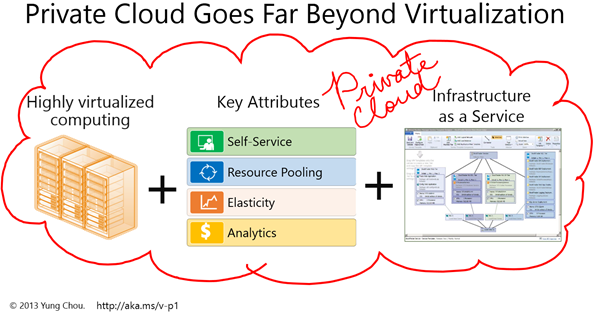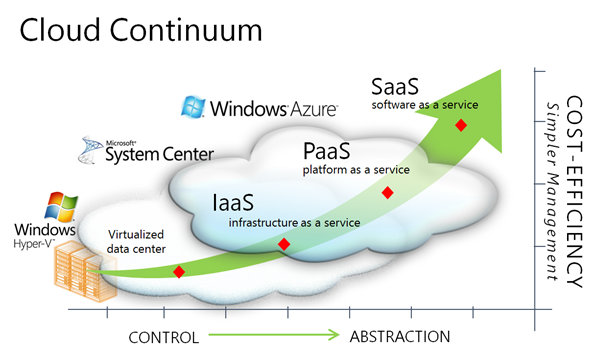Why Private Cloud
Some IT decision makers may wonder, I have already virtualized my datacenter and am running a highly virtualized IT environment, do I still need a private cloud? If so, why?
The answer is a definitive YES, and the reason is straightforward. The plain truth is that virtualization is no private cloud, and a private cloud goes far beyond virtualization. (Ref 1, Ref 2)
Virtualization Is No Private Cloud
Technically, virtualization is signified by the concept of “isolation.” By which a running instance is isolated in a target runtime environment with the notion that the instance consumes the entire runtime environment despite the fact that multiple instances may be running at the same time with the same hosting environment. A well understood example is server virtualization where multiple server instances running on the same hardware while each instance runs as if it possesses the entire runtime environment provided by the host machine.
A private cloud on the other hand is a cloud which abides the 5-3-2 Principle or NIST SP 800-145, the de facto definition of cloud computing. In other words, a private cloud as illustrated above must exhibit the attributes like elasticity, resource pooling, self-service model, etc. of cloud computing and be delivered in a particular fashion. Virtualization nonetheless does not hold, for instance, any of the three attributes as a technical requirement. Virtualization is about isolating and virtualizing resources, while how a virtualized resource is allocated, delivered, or presented is not particularly specified. At the same time, cloud computing or a private cloud, is visualized much differently. The accessibility, readiness, and elasticity of all consumable resources in cloud computing are conceptually defined and technically required for being delivered as “services.”
Essence of Cloud Computing
The service concept is a center piece of cloud computing. A cloud resource is to be consumed as a service. This is why these terms, IaaS, PaaS, SaaS, ITaaS, and XaaS (everything and anything as a service), are frequently heard in a cloud discussion. A service is what must be presented to and experienced by a cloud user. So, what is a service?
A service can be presented and implemented in various ways like forming a web service with a block of code, for example. However in the context of cloud computing, a service can be precisely captured by three words, capacity on demand. Capacity here is associated with an examined object such as cpu, network connections, or storage. One-demand denotes the anytime readiness with any network and any device accessibility. It is a state that previously takes years and years of IT disciplines and best practices to possibly achieve with a traditional infrastructure-focused approach, while cloud computing makes “service” a basic deliver model and demand all consumable resources including infrastructure, platform, and software to be presented as services. Consequently, replacing the term, service, with “capacity of demand” or simply “on demand’ brings clarity and gives substance to any discussion of cloud computing.
Hence, IaaS, infrastructure as a service, is infrastructure on demand. Namely one can provision infrastructure, i.e. deploying virtual machines (since all consumable resources in cloud computing are virtualized) based on needs. PaaS means platform as a service, or a runtime environment available on demand. Notice that a target runtime environment is for running intended applications. Since runtime is available on demand, an application deployed to the runtime will then become available on demand, which is SaaS, or software available on demand or as a service.
Private Cloud Is to Ultimately Deliver IT as a Service
Logically, building a private cloud is the post-virtualization step to continue transforming IT into the next generation of computing with cloud-based deliveries. The following schematic depicts Microsoft’s vision of transforming a datacenter from infrastructure-based deployments to a service-centric cloud delivery model.
Once resources have been virtualized with Hyper-V, System Center 2012 SP1 builds and transforms existing establishments into an on-premise private cloud environment based on IaaS. Windows Azure then provides a computing platform with both IaaS and PaaS solutions for extending an on-premise private cloud beyond corporate boundaries and into a global setting with resources deployed off premise. This hybrid deployment scenario is emerging as the next generation IT computing model where IT’s ultimate missions to deliver and support business functions will be carried out and maintained as services.
To Cloud or Not to Cloud, That Is Not the Question
So what is cloud exactly?
Cloud, as I define it here, is a concept, a state, a set of capabilities such that a targeted business capacity is available on demand. And on-demand denotes a self-servicing model with anytime readiness, any network and any device accessibility. Cloud is certainly not a particular implementation since the same state can be achieved in various implementations as technologies continue to advance and methodologies evolve.
Comparing apples to apples, there is few reason that a business does not prefer cloud computing over traditional IT. Why one would not want to acquire the ability to adjust business capacity based on needs. Therefore, to cloud or not to cloud is not the question. Nor about security is the issue. In most cases, cloud is likely to be more secure as managed by a team of cloud security professionals in a service provider’s datacenter, as opposed to be implemented by IT generalists wearing multiple hats while running an IT shop. Cloud is about how critical the on-demand capability means to a business and for certain verticals, the question is more about regulatory compliance. And above all it is about a business owner’s understanding and comfort level with cloud.
IT nevertheless does not wait, nor can simply maintain status quo. Why private cloud? The pressure to produce more with less, the need to be instantaneously ready and respond to a market opportunity is not just a pursuit of excellence, but a matter of survival in today's economic climate with ever increasing user expectations. One will find out that a private cloud is a vehicle to facilitate and transform IT with increasing productivity and reduced TCO over time as discussed in the Building a Private Cloud blog post series. IT needs a private cloud to shorten go-to-market, to encourage consumption, to accelerate product adoption, to change the dynamics by offering better, quicker, and more with less. That is the reality of IT. That is why.

